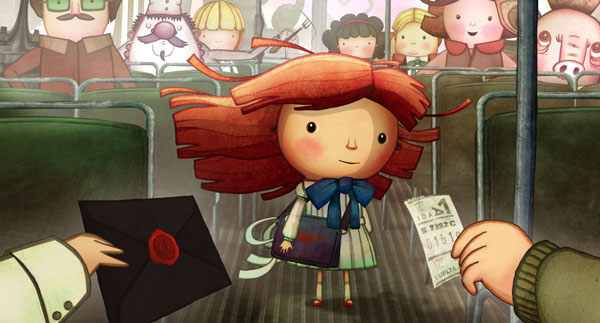Here we go – the entire filmography of animated features from Uruguay. The good news: There are only two. After 18 columns on French animation, here is something that I can cover in just one column!

Selkirk, el Verdadero Robinson Crusoe, directed by Walter Tournier. 80 minutes. February 2, 2012.
This was a Uruguayan-Argentine-Chilean co-production, advertised as the first stop-motion feature made in Uruguay. Tournier, the director, is Uruguayan, and his Tournier Animation studio in Montevideo that specializes in stop-motion animation, shot all of the animation between May 2010 and August 2011. (Argentina handled the sound and post-production, and Chile arranged the financing.)
Alexander Selkirk may have been the real marooned sailor that Daniel Defoe based his Robinson Crusoe upon, but the movie does not pretend to be more than family fantasy-entertainment. Selkirk, an early 18th-century privateer, gets a map to a supposed buried pirate treasure on a South Pacific island. He persuades British nobles and bankers to finance an expedition to get it. They hire the Hope, an English galleon under Captain Bullock, with Selkirk and his map as the sailing master/pilot. The crew gambles during the voyage to the island, and Selkirk loses his share of the treasure. Selkirk manages to alienate everyone, especially Captain Bullock, who orders him marooned on the island. The animated puppets are stylized similarly to the surreal models used in Tim Burton’s stop-motion movies.

Anina, directed by Alfredo Soderguit. 80 minutes. April 19, 2013.
Anina – full name Anina Yatay Salas – is a ten-year-old 5th-grade girl who does not appreciate her name being three palindromes; words that are the same spelled backwards or forwards. The movie’s tagline is: “La única niña capicúa que jamás hubo en una escuela” – There has never been a palindrome girl at the school before. Anina is constantly teased about her name by her schoolmates, especially by her worst enemy, Yisel, a fat girl whom Anina calls a “she-elephant” – they both have a romantic crush on the same handsome boy, Yonatan. One day Anina and Yisel get into a playground fight so bad that both are sent to the principal. She gives both girls a “weird” delayed punishment; each is given a black envelope, sealed with an ominous red seal, that they are forbidden to open for a week, with their punishment-to-be inside it. Anina has nightmares and wild imaginations (shown in the animation) for the week about what the punishment will be, which lead her and her best friend Florencia into trying to steal and open Yisel’s envelope, and other “learning experiences” with her classmates and ultimately with Yisel herself. A running subplot is Anina’s relations with her parents, especially her palindrome-loving father, who encourage her to be proud of her unique name.
Anina, a cel-animation feature based upon a children’s book written by Sergio López Suárez and illustrated by director Soderguit, was a co-production of Uruguay’s Raindogs Cine and Colombia’s Antorcha Films. It was advertised as “embracing Uruguay’s cultural peculiarities and uniqueness”. It premiered at the 2013 Berlin Film Festival (two months before its general release), was Uruguay’s entry for the Best Foreign Language Film in the Academy Awards for that year, and was also a selection of the 2014 Palm Springs International Film Festival, the 21st (2014) San Diego Latino Film Festival, the 38th (2014) Cleveland International Film Festival, and others.
Next week: Something New.


 Fred Patten (1940-2018) was an internationally respected comics and animation historian. He has written about anime or comic books for publications ranging from Animation Magazine and Alter Ego to Starlog. He was a contributor to The Animated Movie Guide (2005), and is author of Watching Anime, Reading Manga (2004, Stone Bridge Press), a collection of his best essays, and Funny Animals and More (2014, Theme Park Press), based upon his early columns here on Cartoon Research. He passed away on November 12th, 2018.
Fred Patten (1940-2018) was an internationally respected comics and animation historian. He has written about anime or comic books for publications ranging from Animation Magazine and Alter Ego to Starlog. He was a contributor to The Animated Movie Guide (2005), and is author of Watching Anime, Reading Manga (2004, Stone Bridge Press), a collection of his best essays, and Funny Animals and More (2014, Theme Park Press), based upon his early columns here on Cartoon Research. He passed away on November 12th, 2018.





































I probably should have described “Anina” as hand-drawn animation rather than as cel-animation.
How many contries have you covered?
So far, only Japan, France, and now Uruguay. But read next week’s column!
Wouldn’t mind one on Spain or Italy!
After 2+ years, I am running out of topics for weekly columns, so I will probably research and cover Spanish and Italian animated features soon. Ooh, that Italian movie about the sinking of the Titanic, absolutely accurate with a happy ending where all the passengers (including the funny animals) are rescued. Hmmm, how many animated versions of “Pinocchio” have there been? Besides Disney, have there been any “Pinocchio” animated features that aren’t Italian?
Good question, I guess Italy takes the cake with their many adaptations.
There’s a Russian animated film based on a story similar to Pinocchio, The Adventures of Buratino. It’s half likely you’ve already heard about it in the last five days but I’ll bring it up in case you haven’t.